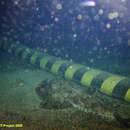Biology
(
Inglês
)
fornecido por Arkive
The anglerfish lies half-buried in the mud or sand on the bottom of the sea, attracting fish to its huge mouth by means of its lure. Fish are drawn in by the sudden inrush of water. This method of feeding is a speciality of the various groups of anglerfish worldwide.
Anglerfish spawn between May and June in British waters, and between June and August in the North Atlantic. The eggs, numbering up to a million, are contained in a band of mucus about 10 metres long, released to drift in the open ocean. The larvae, when they hatch, look just as extraordinary as the adult fish. They mature at a length of 40 cm and at an age of four years for males, and a length of 70 cm and an age of six years for females. A fully-grown adult anglerfish may live for 20 years or more.
Conservation
(
Inglês
)
fornecido por Arkive
The anglerfish is listed in the UK Biodiversity Grouped Species Action Plan for deep-water fish. The European Union (EU) has regulatory powers over commercial sea fishing for member countries but allows individual nations some flexibility in the application of the EU rules.
The commercial exploitation of anglerfish is governed by the total allowable catch (TAC) regulations. Catches in the North Sea and west of Scotland, areas monitored by the International Council for the Exploration of the Sea (ICES), are covered by precautionary TACs. However, the fishing industry has been lobbying for an increase, and permission to extend the catching of anglerfish into deeper waters. ICES has suggested that commercial deep-sea fishing could pose a serious threat to many species as numbers are below safe biological limits. For other species, we simply do not know the size of their populations. ICES has recommended that unsustainable commercial deep-sea fishing should therefore be reduced, and better records kept of fishing activities so catches can be equated to known fish population sizes. At the present time, anglerfish are being overfished, and there are no management plans for its conservation.
The deep-sea ecosystem is still largely unexplored and understudied. However, we do know that it is a fragile system. Unregulated, unsustainable commercial harvesting of fish stocks risks wrecking this fascinating habitat before we have learned of its importance and value to the ocean as a whole.
Description
(
Inglês
)
fornecido por Arkive
The various names for this fish - anglerfish, monkfish, goosefish - point to the fact that it has a very unconventional appearance, as indeed do all 24 members of this family of fishes. At first glance, it appears to be all head – and a head almost as wide as the whole fish is long - with the flattened body tapering sharply towards the tail. The skin is dark, rough and knobbly and has no scales. Despite its unappetising look, anglerfish are a commercial species, and considered good eating, although the tail is usually the only part of the fish displayed on most fishmongers' slabs. Other notable features of this fish include an enormous, crescent-shaped mouth on the upper half of the body, and the presence of three long spines on the head between the eyes; the front spine is modified to act as a lure, bringing prey fish within reach of the anglerfish's mouth. The dorsal and ventral fins are placed way back on the tail, and the two large limb-like pectoral fins have gill slits located directly behind them.
Habitat
(
Inglês
)
fornecido por Arkive
The anglerfish frequents the coastal, deep continental shelf regions, on the sandy or muddy sea bottom, at depths ranging from 20 to 1000 metres.
Range
(
Inglês
)
fornecido por Arkive
The anglerfish range extends along the eastern Atlantic, along the Norwegian coast of the south-western Barents Sea, down to the Straits of Gibraltar, and includes the Mediterranean and Black Sea. There are also records from Icelandic waters.
Status
(
Inglês
)
fornecido por Arkive
Not subject to protection.
Threats
(
Inglês
)
fornecido por Arkive
The biology of deep-water fish such as the anglerfish is still relatively unknown and with deep-water fishing largely unregulated, it has proved difficult to assess whether populations of these fish are being adversely affected. Another problem associated with many deep-water species is their late maturity, meaning that there is a greater risk of them being caught before reaching reproductive age.
When these deep-water fish are caught accidentally (bycatch) as often happens with indiscriminate trawling, they are unable to survive being hauled up to the surface, and are already dead before they are returned to the sea.
These large predatory fish are thought to be top of the food chain within the ecosystem they inhabit, and there are fears that commercial overfishing of their food, and subsequent damage to their habitat by weighted trawl nets, could have an adverse effect on populations.

